#anatomy reconstruction discuss
Explore tagged Tumblr posts
Text
LEPTO HEAD ANATOMY ALERT
I was so obsessed with the anatomy of UDANOCERATOPS, so, I start studying body build of its closest and most accessible relative.. LEPTOCERATOPS.
I found Sketchfab 3D model by Inhuman Species (aka justin.vl). This model was made for an exhibit at the Badlands Dinosaur Museum with Dr. Denver Fowler validation:


Inhuman Species shared in FB with some references after I asked:


Truly this is the only good reference for ALL Leptoceratopsidae at the present time. Why? Cause it's impossible to find ANY FOSSIL PHOTO. Although it don't possessing fully scientific accuracy: Justin message to me "there's an element of interpretation, especially for the inside of the skull".
Well, it doesn't stop me using critter as reference


Behind-the-sketches and pain in the ass


I made own amateur research & comparisons between the drawing by Paleofile, CMN 8887 casts by WitmerLab and Royal Tyrrell Museum with Justin's model, so it's ± accurate
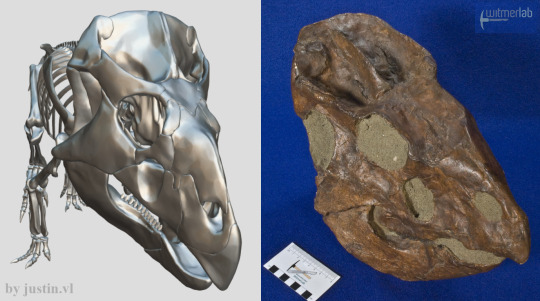



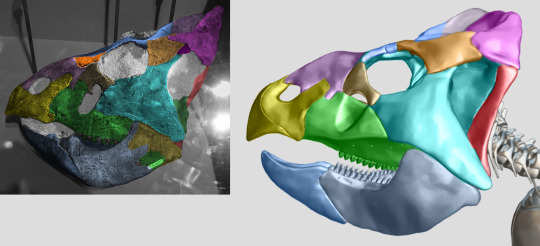
Wiki also says that CMN 8887 specimen are young (unfused skull bones). And I think that surveyed is the older one:

I also noticed that frill of Leptoceratopsidae was short, but massive. It clearly intended for musculature for bite force, not for display.
Moreover, they have gigachad deep jaw.
I even compared Protoceratops with Leptoceratops!
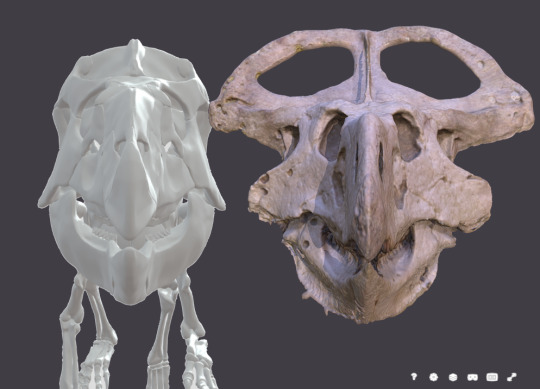


phew
#how to draw#dinosaur#leptoceratops#reference#anatomy#anatomy reconstruction discuss#fossil#leptoceratopsidae#paleoart#paleontology#prehistoric#ceratopsian#cretaceous#udanoceratops close relative
20 notes
·
View notes
Text
Varanosuchus: First Fossil Croc of 2024
We are two weeks into the year and we already had a bunch of big croc papers, so today I'll cover the first of the two new genera named so far. Varanosuchus sakonnakhonensis (Monitor lizard crocodile from Sakon Nakhon) is a small atoposaurid neosuchian from the Early Cretaceous of Thailand, a country that has seen a virtual boom in croc papers this past year between the description of Alligator munensis and Antecrocodylus.
Varanosuchus was a small animal, maybe a meter in length if a little longer with a notably short and deep skull and long slender limbs revealing it to have been at least somewhat terrestrial. We actually have a decent amount of material of this guy. The holotype consists of a 3 dimensionally preserved skull as well as assorted postcranial remains (vertebrae, ribs, osteoderms and limbs), there is a second skull of whats likely to be a differently aged individual also showing a 3D skull and well the third ones just a skull table but 2/3 is still great.
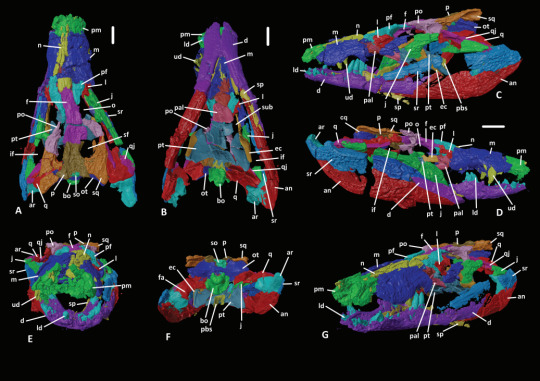
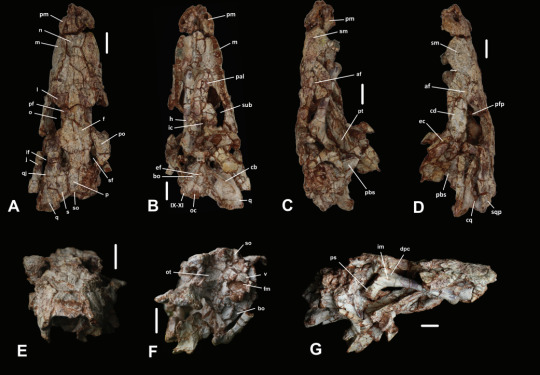
Now this guy was an atoposaurid, which is a group of crocodylomorphs that lived from the Jurassic to the end of the Cretaceous, their last members existing on the island of Hateg some 66 million years ago. Atopsaurids were generally small animals with short snouts and longish legs. Some examples of atoposaurids include Knoetschkesuchus from Germany, Aprosuchus from Romania and Alligatorellus from France and Germany, all three pictured below, art by @knuppitalism-with-ue
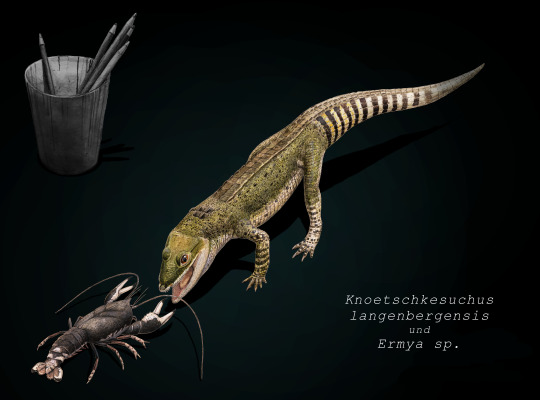
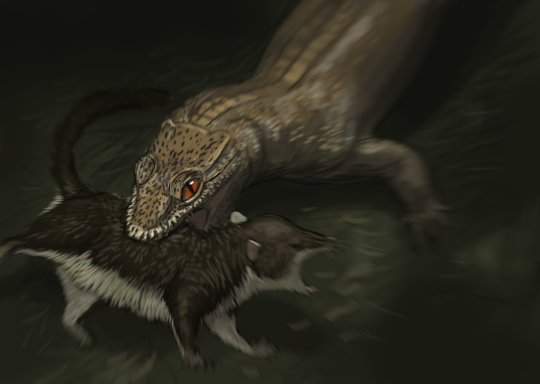
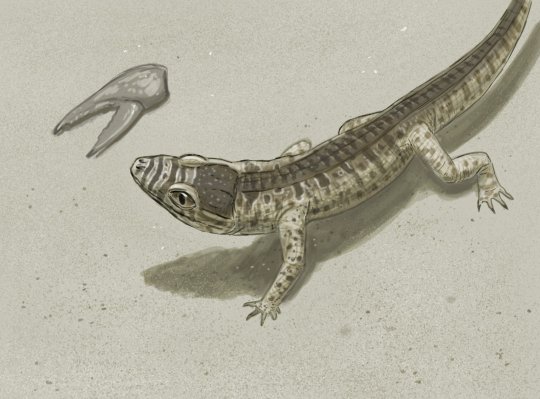
Now the matter of ecology for atoposaurids in general and Varanosuchus in particular is not clear. Altirostral skulls such as that of Varanosuchus are generally associated with terrestrial crocodylomorphs as best examplified by notosuchians. Their teeth and size both obviously speak against being shoreline ambush predators like modern crocs and their legs are straight and slender, suggesting they had an erect posture and not the more sprawling one seen in semi-aquatic forms. Though they could have still had some aquatic affinities. The authors for instance argue that the osteoderms, having plenty of pits, are more like those of an animal that spends time in the water and would thus use them in thermoregulation. So maybe they did enter water from time to time, somewhat like some modern lizards, tho I think its fairly certain that they spend a decent amount of time on land. The artwork below is the reconstruction from the paper itself.
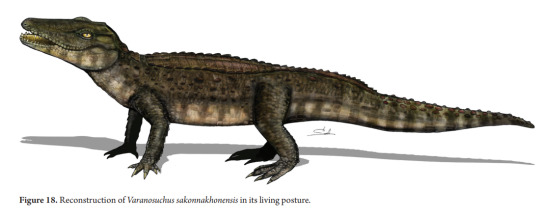
Another matter discussed in the paper is phylogeny, more precisely the relationship of Neosuchians and how Eusuchia is defined. On the first front, its worth noting that the paper recovered both atoposaurids and paralligatorids as monophyletic groups and had them be each others closest relatives, a notion that has been recovered before. More interesting perhaps is the fact that the next closest relatives to these two were hylaeochampsids and Bernissartia, which are typically recovered closer to modern crocs. Which in fact form a separate branch that is the sister group to all the afforementioned clades and taxa. And then you got goniopholids, dyrosaurs and pholidosaurs which are all more basal than the paralligatorid+atoposaurid+crocodilian group, which is back to the ordinary really. The second thing is the definition of Eusuchia. So for the longest time Eusuchia has been defined to include those Neosuchians that have choanae that are fully enclosed by the pterygoid bones (I know I know a bunch of anatomy stuff bear with me). So if the choanae was surrounded by the pterygoid, its an Eusuchian, if not, its more basal. Well, atoposaurids don't have that....BUT VARANOSUCHUS DOES. This, coupled with hylaeochampsids also having this feature and being recovered closer to atoposaurids than to Crocodilians basically suggests that the feature is not diagnostic for Eusuchia and instead appeared multiple times independently.
Moving away from anatomy and phylogeny and all that stuff, I think its very cool that croc research in Thailand has kinda picked up this last year. And fittingly enough some people have even worked on a short documentary covering the known diversity of pseudosuchians from Thailand, giving an overview over the named forms from the Jurassic to today, from titans like Chalawan to even these newest dwarf forms. While the narration is obviously in Thai, there are English subs and I highly recommend looking into it (even if I disagree with their depiction of Varanosuchus as arboreal, its perhaps overshooting the goal a little bit).
youtube
Finally here's the paper itself (tho paywalled) New Cretaceous neosuchians (Crocodylomorpha) from Thailand bridge the evolutionary history of atoposaurids and paralligatorids | Zoological Journal of the Linnean Society | Oxford Academic (oup.com) and the wikipedia page I've been working on Varanosuchus - Wikipedia
I'll try to write up a post on the other new genus, Garzapelta, later this weekend so stay tuned for that.
#varanosuchus#atoposauridae#crocodylomorpha#neosuchia#thailand#cretaeous#pseudosuchia#croc#crocodile#land crocodile#prehistory#paleontology#palaeblr#long post#Youtube
197 notes
·
View notes
Text
Oviraptor Palates

Reconstructed Oviraptor skull be Jaime A. Headden.
Oviraptors are notoriously known for the revision on their feeding habits. Originally thought to have been obligate egg-eaters, the findings that associated eggs were actually their own has sparked controversy about their actual feeding habits. Some have suggested a mollusc based diet, others an omnivorous but fruit and seed based diet.
A relatively under discussed part of this debate revolves around their palate. Oviraptors possess two projections that end up in tooth-like structures. When they were assumed to be egg eaters they were considered vital in piercing egg shells (Osborn 1924), and Barsbold suggested that they could have been used to pry mollusc shells open (Barsbold 1977). Other studies have found that the jaws of oviraptorids were more suited for shearing rather than crushing, but they have since been rejected (Funston et al 2018). Still, these newer studies don’t explore much in the way of function for the strange palate.
A possible explanation is that they were used to manipulate objects in the mouth, perhaps keeping seeds and fruits in place while the beak crushed them. Given the presence of a lizard in one specimen’s innwards (Norell et al 1995), they could’ve have function like the raised palate of predatory birds, though in that case they would have been more raptorial than recent studies on their diet suggest.
Ultimately, this seems to parallel how some mammals with “herbivorous dentition” are in fact more carnivorous than their anatomy suggests (Hu Y et al 2009), only perhaps in reverse.
Needless to say, more studies are welcome.
References
Osborn, H. F. (1924). “Three new Theropoda, Protoceratops zone, central Mongolia”. American Museum Novitates (144): 1−12. hdl:2246/3223. OCLC 40272928.
Barsbold, R. (1977). “Kinetism and peculiarity of the jaw apparatus of oviraptors (Theropoda, Saurischia)”. Soviet-Mongolian Paleontological Expedition, Trudy. 4: 37−47
Funston, G. F.; Mendonca, S. E.; Currie, P. J.; Barsbold, R.; Barsbold, R. (2018). “Oviraptorosaur anatomy, diversity and ecology in the Nemegt Basin”. Palaeogeography, Palaeoclimatology, Palaeoecology. 494: 101−120. Bibcode:2018PPP…494..101F. doi:10.1016/j.palaeo.2017.10.023.
Norell, M. A.; Gaffney, E. S.; Dingus, L. (1995). Discovering Dinosaurs In the American Museum of Natural History. Knopf Inc. p. 225.
Hu Y, Meng J, Clark JM (2009). “A new Tritylodontid from the Upper Jurassic of Xinjiang, China”. Acta Palaeontologica Polonica. 54 (3): 385–391. doi:10.4202/app.2008.0053.
12 notes
·
View notes
Text
I try my best to be neutral about things I don't really like, but I think we need to reframe the way we discuss the classical world. I'm not saying you can't have fun with it—I think it's fascinating, and that's why I study it—but the Greek Mythology resurgence has led to a kind of weird mentality surrounding ancient religion, culture, and languages. There is no set 'canon' here, or 'one true version' of a myth; what we think of as Greek Mythology is a collection of stories pulled together from hundreds of city states with their own unique oral traditions, smashed into one broader narrative by various historians and poets. The details are going to vary, and that's normal—especially because most people are reading these stories in translation. Even if there was One True Original Story, you have no way of knowing what that is unless you learn to read Homeric Greek. Which was already a challenge for most of the other Greek writers you're familiar with.
Go and enjoy Epic or anything else you like. I think it's cool that more people are being introduced to classic literature right now, and I really hope that trend continues. I just wish people understood that they're engaging with a piece of collective culture, not something cohesive like the MCU. Details are going to vary, ancient writers have different takes on things, and that does not automatically make them worthless. Please let your interest in Homeric work take you other places. You can find a lot of interesting works online—for free!—that either influenced the things you already like, or built off of them. So here are a few of my recommendations.
The Descent of Ishtar, read by Martin West. I think it's important to note that Greek religion was heavily influenced by other existing traditions, and vice versa, since a lot of people seem to believe Greece is the original and other cultures simply 'copied.' This translation here is really lovely, AND you get the chance to listen to reconstructed Akkadian.
The Hippocratic Corpus, translated by Francis Adams. This is a pretty decent translation, and worth a read because it highlights 1. theological debates happening in real time over the causes of different illnesses and 2. the tendency Greeks and Romans had to attribute all noteworthy developments in a single field to one person. Homer probably didn't exist, at least not in the capacity we often think of, and neither did Hippocrates—so many of the texts in his own 'corpus' are in complete disagreement with each other. That said, they're still extremely useful. Airs, Waters, Places is a particularly important read in my opinion because it is intentionally xenophobic. Half of this text is a justification for the natural inferiority of Persians and all cultures ruled by or allied with the Achaemenid Empire, and this is not an uncommon opinion in Ancient Greek writing. I think it's important more people are aware of that since Ancient Greece is frequently idealized. Plus you'll get to read some VERY strange descriptions of human anatomy. Wait until you find out about how sperm makes your hair turn white.
Parallel Lives by Plutarch. Later Greek writers often get overlooked in favor of their predecessors, but Plutarch is particularly interesting because of the gap he's choosing to bridge: each section of Parallel Lives is a comparison between a significant Greek historical figure, and a significant Roman one. I can't not include Plutarch, especially since his section on Alexander the Great is one of our best sources of information on the man (no, seriously, we have lost SO much information over time). Anyway, I highly recommend it as a read. Perseus (the reading software) can be a little bit finicky, but this translation is pretty solid compared to some of their other, older available works.
#dex rants#i would have included vergil if i'd found a free translation of his works i liked but i did not so...#i'll just tell you to read the georgics and the eclogues down here#the aeneid is his masterpiece and my favorite piece of epic poetry ever but it's also hard to find a good translation#and if you're very into greek mythology i'm going to bet you have some preconceptions of him that you should break first#with one of his other pieces.#classics#classical literature#greek mythology#homer#vergil#plutarch
8 notes
·
View notes
Text
By: Genspect
Published: May 15, 2025
In May 2025, Texas passed Senate Bill 1257 (SB 1257) with an 87-58 vote in the House. This law requires insurance providers covering sex-trait modification treatments, such as hormone therapy or surgeries, must also fund complications, reconstructions, and recovery care. Genspect has worked on this bill since 2022, and we believe it should inspire similar legislation across the nation and the world. Why is this significant? How will it reshape Texas and potentially influence other regions? Let us explore.
So called gender transition treatments and procedures—hormone therapy, surgeries, and related interventions—are often promoted as solutions for distress by organizations like WPATH, the American Academy of Pediatrics, and the Endocrine Society. However, recent findings, including the HHS report and the Cass Review, reveal weak evidence for the safety and efficacy of these treatments. President Trump’s Executive Orders on gender, which cut funding for institutions offering such procedures, will likely reduce their prevalence. Yet, as long as insurance providers and Medicaid cover these interventions, they will persist.
While insurance often funds medicalized sex trait alterations, it often excludes costs for addressing complications, reconstructions and on-going health monitoring. This gap is not merely a practical issue for tens of thousands of individuals; it conceals the crisis of iatrogenic harm caused by these procedures.
Proponents of sex-trait modification treatments have long dismissed detransition as a myth and claimed complications are rare. They sustain this narrative partly because the system operates like a conveyor belt: when initial interventions fail to deliver desired outcomes, further procedures are presented as solutions. For those seeking to reverse course, returning to the practitioner who initiated their path is often the last thing they want to do. Additionally, the medical system lacks diagnostic and billing codes for unique complications—like vaginal atrophy in a 25-year-old masculinized woman or fistulas in a surgically constructed anatomy—rendering these adverse effects invisible.
Senate Bill 1257 addresses this issue directly. It requires insurance providers covering such procedures to also fund care for complications or reconstruction and on-going health monitoring. Imagine undergoing surgery only to discover that insurance will not cover follow-up care if healing falters—that is a crushing burden. This bill prevents such scenarios, offering critical support for individuals who detransition, a group gaining increasing recognition. It ensures assistance is available, regardless of the path chosen.
How will this change the landscape? The legislation will likely encourage greater caution among physicians and insurers. Doctors may perform more rigorous evaluations before recommending medicalized sex alteration, ensuring patients understand the risks. Insurers may become more discerning about what they cover; however, they must continue to care for those who have already undergone these treatments. The bill will also reveal the true scope of post-medicalization complications, reducing cases of individuals facing unaffordable bills after procedures go wrong. Furthermore, it may foster more transparent discussions about the risks and benefits of these interventions, benefiting all involved.
What can we expect in Texas and beyond? In Texas, Senate Bill 1257 aligns with existing policies, such as Senate Bill 14 (2023), which restricts sex-trait modification treatments for minors. This new law extends some protection to adults, addressing a critical gap.
Could this approach spread? We hope so. Other regions, particularly those with similar healthcare perspectives, are observing Texas closely. If Senate Bill 1257 proves effective, other states may adopt comparable measures. Unfortunately, most insurance plans are regulated federally. To ensure protection for all citizens, similar policies must be adopted in Washington.
Ultimately, Senate Bill 1257 ensures individuals facing challenges are not abandoned. Though not flawless and likely to face opposition, it marks a vital step toward a healthcare system that supports people navigating gender distress.
==
If detransition is "rare," then there should be no opposition to this bill. Nobody is going to need it, right?
Some of these retards even tout that Rogaine, liposuction and haircuts are "gender affirming care." But somehow, a girl with a beard, no breasts and a baritone voice trying to detransition to look female again is not.
#Genspect#sex trait modification#insurance#medical scandal#medical corruption#medical malpractice#detransition#detrans#gender affirming care#gender affirming harm#gender affirmation#gender affirming healthcare#hormone therapy#cross sex hormones#wrong sex hormones#religion is a mental illness
2 notes
·
View notes
Text

Archangel from Uncanny X-Men (2016) #7
Fandom: X-Men (comics) Characters: Warren Worthington III Credits: Greg Land — [ Reblogs > Likes | No AI involved ] —
Full Archangel from the cover of Cullen Bunn's Uncanny X-Men #7.
———————————————————————————————
An exercise that took way more time that it seems. The original art features Warren as perfectly split in two, depicting his two sides (Angel on the left and Archangel on the right).
———————————————————————————————
Other content about the character linked above.
———————————————————————————————
Notes This came out of a discussion over CBR forums, where a poster commented that something was "off" in the anatomy. To check where was the issue, I played with the two halves; while Angel's side is very off, and would need heavy reworking from navel down to fix it, Archangel worked, so I decided to work to make a finished art.
Greg Land did a similar cover with Betsy Braddock for Uncanny X-Men #509, where he again fucked up with the hips and legs proportions. I tried a couple of months ago to work on that art, but I couldn't fix the issue. I might give it another try in the future. Or try a Warren-Betsy two pieces (Angel-Caucasian!Psylocke / Archangel-Ninja!Psylocke).
———————————————————————————————
Tec stuffs (aka Behind The Manip) I took the original half (right) and flipped it. It was necessary to do some reconstruction/redraw to make the two parts blend, especially the decorations of the glass behind Warren. Betsy's face too needed to be fixed. I moved her a little higher, so she aligned to Mystique, but that required some redraw too. Also, her colors needed a fixing to remove the sun/golden light. The textless version I used had a portion of the legs covered, so I had to copy them from another source and blend the two parts. Lastly, changed Archangel's eyes from yellow to red (as in canon), and made it more silver. Also added some light.
No AI involved. All made with a mouse, not pens involved (that would've have shortened the time). Just Photoshop CS2.
Credits Original art by Greg Land with Nolan Woodard, released as main cover for Uncanny X-Men (2016) #7.
———————————————————————————————
Crossposted Livejournal: prue84.livejournal.com/105945.html Dreamwidth: prue84.dreamwidth.org/96830.html Deviantart: deviantart.com/prue84/art/Archangel-from-Uncanny-X-Men-2016-7-1135250865
3 notes
·
View notes
Text
Crelog #1
(for optimal viewing, please use a computer and blog address ^^)
First Novinitum D crelog! (creator log, i know very creative). These are basically like devlogs but for my specevo and worldbuilding projects. Entries where it's me updating yall on the behind-the-scenes stuff and also asking for feedback on occasion, maybe even a poll, we'll see.
In this entry I'll be discussing the progress I've made on the first taxon of the project, the infamous fish I've been spamming on my socials for the past week (it finally has a name!). And I'll also be discussing my process on the map and fleshing out the geological past and future of Novinitum D.
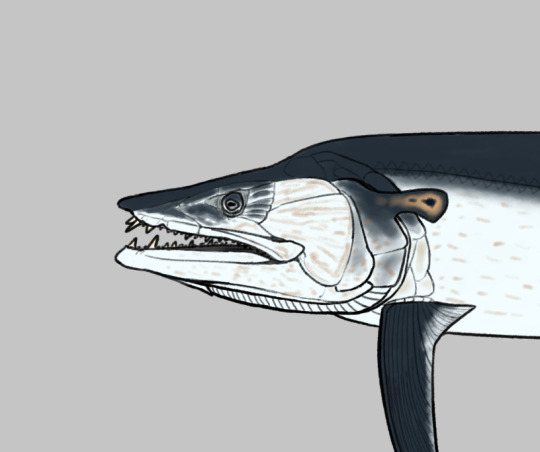
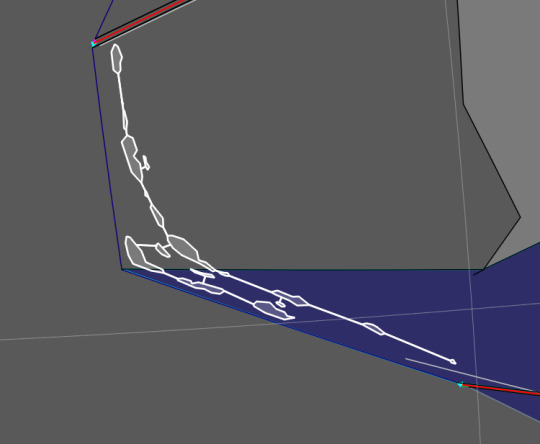
sneak peak into what this crelog features
[#1] -> Next crelog [#2] 🗒️Crelogs🗒️
~~~~~🐟🐟🐟~~~~~
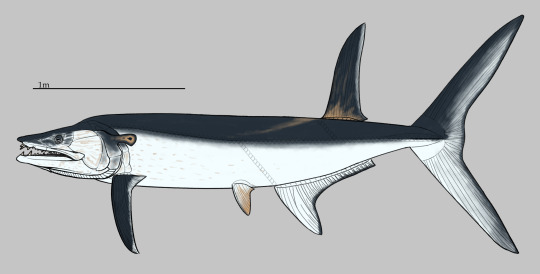
Operculaurisichthys pelagicus, the type species of Operculaurisichthys (yes that's the name people, write it down write it down!!!)
Enter Operculaurisichthys, the 'eared operculum fish'. This entire project only exists because one night I sat down, drew a made up fish (this one) and thought to myself "what if I started a seed world with this fish?". Now this figure is actually slightly innaccurate now but not noticably so to most people so I think it's fine using it in a crelog, updated figures will be used in its dedicated taxon article anyways.
I wanted to talk about it because 1. it's awesome, and 2. phylogeny.
As many of you know, I created this fish without any intention of clade in mind, that said however, I very much had pachycormids on my mind at the time because they sparked my fish anatomy hyperfixition (fish people will know why I've shot myself in the foot doing that). This means that I unknowingly made its anatomy nearly identical to a generalised pachycormid as pointed out by Sky Jung in a VC (check him out on twitter: @HBivittatus and insta: @teleostei_art). Jumping off of that observation, I created a modified phylogenetic character matrix based on the first matrix in Cooper et al., (2022) in Mesquite.
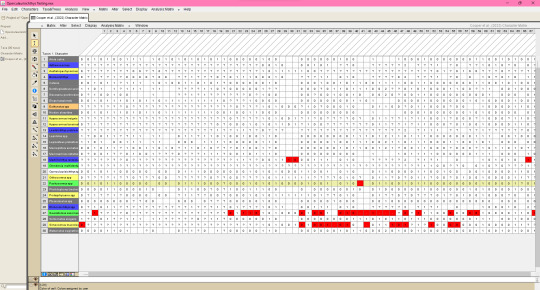
A little look into the character matrix within Mesquite, 130 characters and 30 taxa in this one
I'll go more in detail in its dedicated taxon article about what exactly was modified in some sort of phylogeny section probably.
After sorting out all the characters for the Operculaurisichthys spp. (yes there are multiple species, more about that in a future crelog probably) I imported the .nex file into TNT which I used to create the majority rule consensus tree you see below.
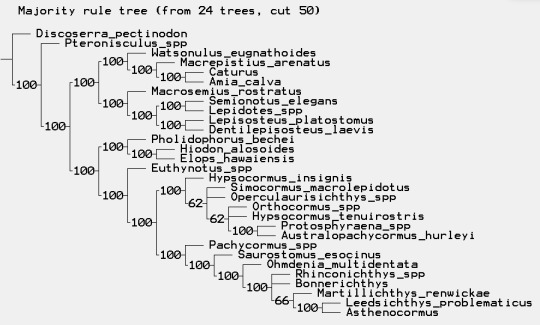
Everything before Euthynotus spp. is part of the outgroup, so I wouldnt pay them much attention, as you can see, this majority rule consensus tree is the result of 24 most parsimonious trees
The inclusion of Operculaurisichthys didn't break Pachycormidae to my surprise, which is incredibly impressive for a fish that was made with no clade in mind. As you can see its firmly nested within Hypsocorminae in a polytomy with Simocormus and the more derived hypsocormines, which I find incredibly interesting for the afformentioned reason.
Anyways that's all I'm gonna talk about regarding Operculaurisichthys, so if you just came for that now's your chance to leave. Onto GPlates stuff and plate tectonics!!!
~~~~~🌎🌍🌏~~~~~

A sneak peak at the GPlates project file, just the sea side tho can't give everything away too early can I now ;P
What is GPlates? I think their website puts it best "GPlates is a plate tectonics program (where you can) manipulate reconstructions of geological and paleogeographic features through geological time." What I'm doing is simulating the plate tectonics through geological time to give my world a realistic look and assure I can keep that same realistic look throughout the course of the project.
I'm using the GPlates portion of Artifexian's worldbuilding series (link to the playlist here) mixed with referencing Worldbuilding Pasta's blog (link to their blog here) which the GPlates portion of Artifexian's worldbuilding series derives from. Artefixian simplifies a lot of stuff to suit his workflow - which is valid - while Worldbuilding Pasta's original method is closer to the level I like, so I cross reference a lot of stuff.
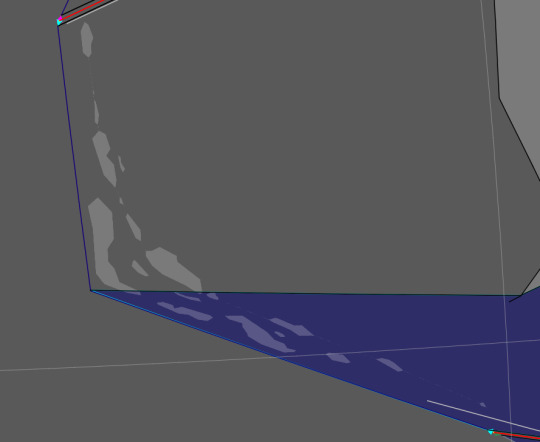
One of the many island arcs on the planet
However one thing I do which is different to both is create the continental shelf portion of my island arcs every 50 million year timestep. This sounds stupid and tedious, but makes sense when you take into account the fact that I'll be making multiple of these maps every 50 Million year timestep or so (still deciding on that). So having that reference and being able to simulate the building of terrain over time is incredibly useful.
Ontop of this I'm also adding an accurate amount of terrain using the equation: (island arc length * age of island arc in MY) / 2 (which is taken from this Artifexian video). This is an incredibly tedious process but imo worth it in the end.

Earlier version of the above island arc showing that it's all one connected element, please understand how tedious this is lmao
So yeah! That's pretty much all I'm willing to reveal right now, hope this gives yall an idea what you're in for and also a look at my creative process (aka my flavour of autism). There will definitely be more crelogs in the future, and more frequently as I continue to make more progress in developing the major parts of the world.
For the first time, thanks for reading!
#NovinitumDCrelog#worldbuilding#spec evo#speculative biology#speculative zoology#GPlates#plate tectonics
19 notes
·
View notes
Text
Putting some information out there because I'm seeing many notes from people who seem interested but do not know where to begin looking.
Disclaimer : I am not a medical professional, I am just someone who has wanted bottom surgery for years and thoroughly read on the subject. If something is wrong please let me know. If you do not know what a word means and I don't clarify it, browsers are your best friends. Curiosity is good and I'm trying not to write 60 pages. There is mention of sexual activity and anatomical terms though I'm trying to keep it to the bare minimum. Kinda long post ahead. Alright.
1.Reddit can be extremely useful for surgery info and this is especially relevant when it comes to phallo. The r/phallo subreddit has MOUTAINS of resources, from medical papers and info on implants (like the mentioned erectile device in here for example, there are multiple types), to pictures from kind enough numerous people who document their journey, to surgery team recs/bewares, etc. Though there is a language barrier which causes the sub to be pretty American centric, there are people from all over the world with all sorts of body types, phallo types and goals discussing their journeys. I heavily suggest reading through the FAQ and using the search bar to look up keywords related to your questions before actually asking them, the sub has a tendency to get a bit clogged by repeats unfortunately.
2.Phallo is extremely customizable. There are multiple graft sites to choose from. This individual got RFF which uses the arm, but other techniques can use the thigh, the abdomen. Some even involve growing your penis in your body to reduce scarring! All have their pros and cons and/or require a specific kind of anatomy. RFF is the most common because it is the most widely accessible across bodies and provides great results in firmness and sensation. And that's not all! Phallo can be divided in different parts : You can have a penis you can pee from with a scrotum and no vagina. You can have a penis you can't pee from with a scrotum and no vagina. You can have a penis you can't pee from with a scrotum and a vagina and your original bottom growth still preserved underneath instead of put into your penis (that's mostly done for erotic sensation's sake), etc. There is barely any limit, but your surgeon's ability to make your desired body a reality basically.
Now that I've made the 2 most important points, much more under the cut :
3.Phallo is not just for trans people, it has been and is still being done for cis men (reconstructions after loss from cancer, injuries, etc). I feel this is important to say.
4.The process is rough and I mean it. Your first stage can take years because of waitlists, insurances issues, etc. You WILL take months to recover, you need at least 2-3 weeks of inactivity and even then after that you will have to be physically very inactive for months. You will extremely likely regret getting phallo in the first few months, this is a common thing in major body surgeries, you will be able to assess whether you actually regret it or not much, much later (though that turns out to be rare for the obvious reason most people figure they'll regret it before they get it, and move on). Stages can span multiple years especially with complications. Fistulas are the biggest problem, alongside wound separation, and less commonly strictures. Necrosis is extremely fucking rare but it can happen (though usually at worse you just lose a small bit of your penis and it can still be reconstructed, it will just take time)
5. If you want foreskin really bad, you aren't a Finnish citizen (Gracilis Phalloplasty is a thing), and size doesn't matter to you, there is another bottom surgery type called metoidioplasty, also very customizable, which aims to work with your bottom growth instead of grafts (fun fact, this is the bottom surgery I will be getting). Do remember though plenty people with phallo are happy with their dicks without foreskin.
6.Of course there are a few differences between natal penises and phallo penises; firmness, ability to retract and get hard, maintenance, but there's plenty that can be done to make them as close as possible. If passing/fear of being clocked matters to you for psychological and safety reasons, your phallo dick and the scars it leaves behind will not be a problem. Any graft site can be used for any surgery, not just phallo. Lack of foreskin (even a stage one phallo penis) will not mean you'll get clocked. Most cis people will not look at your dick when it's out of your pants (and if it's in, won't comment on it even if they notice a bulge or whatever, it's a normal society thing I promise). Still on passing, If you are looking to date or looking to be sexually active with cis people who you expect to love dicks on their men (gay men/straight women etc). They LOVE THEM. Don't even worry about it. I promise the strangers you'll encounter won't find your dick weird. In fact especially after later stages (like if you get an erectile device) most are pretty happy about the fact you can get hard on command, but I digress. (Don't forget usual sexual health recs for people with dicks apply to you too, but I'm not your parent).
7. I've had a pretty male focused post thus far I'm afraid, but I insist, anyone of any gender can get phallo if they deem it necessary for themselves. Gatekeeping sucks fucking ass. You are a woman who is deeply troubled because she doesn't have a penis? Don't be ashamed of looking into it. It's probably gonna be a rough road to actually get it though, but that is something for you to figure out, I'm just here to tell you it's okay to begin with. Your gender is some flavor of genderqueer? Nonbinary? Genderfluid? Agender? Me too, don't be afraid of bottom surgery. Whether you think it affirms something manly in you, or something totally different, is up to you and you only.
At the end of the day your damn body, your damn flesh can be turned into a fully working penis and I think that's beautiful.
FAQ based on what I read in notes :
-Adding to what I said earlier but yes you can keep your vagina. Not all surgeons offer urethral lengthening if you want to keep your vagina because of heightened complication risks (mostly fistulas), but is is a possibility. If you decide not to undergo UL majority of surgeons will not fuss. Note : If you want a vaginectomy (rid of your vagina) you need a hysterectomy. Not necessarily a oophorectomy (ovary removal) in my experience but the uterus needs to yeet. I am saying this for all those who would like to carry children someday.
-Yes your balls can become hairy. Phallo dicks might in fact still have some hairs on them (or in which causes complications, hence the hair removal process before the creation of the penis) and it's common to still get hair removal sessions after first stage.
-You can choose your dick and ball size, sorta. Depending on technique and body your team will usually let you know in advance what they think might be possible, from there you can ask for smaller (ie : Your graft site might allow for a penis of 6 inches, you can ask for 4. Your scrotum can finally get implants, and it might allow for medium size implants, you can ask for small ones instead, etc). Just remember surgery remains an unpredictable thing and even if rarely, sometimes things don't go as planned. Majority of the time it works out though, and rather take some risks see what can be done than be forever miserable am I right?
-You can get plenty of orgasms, but don't expect semen to come shooting out of your dick. Some people's Skene's gland does insane work, which means it basically almost looks the same when you've got UL, but that is not the majority.
I hope this fucking wall of text turns out to be helpful to someone out there. Love y'all.
79K notes
·
View notes
Text
What Are the Best AI Undress Tools and How Do They Work?
Artificial Intelligence (AI) tools have grown remarkably in recent years, offering advanced functionalities across many domains—from image enhancement to virtual try-on technologies. However, one category that has drawn both curiosity and controversy is the rise of “AI undress tools.” These tools utilize machine learning and image processing to simulate the removal of clothing from images, typically in a digital or visual context. While the ethical implications are serious and warrant attention, it is important to understand how these tools work, what technologies they use, and which are considered the most accurate or sophisticated.
Understanding AI Undress Tools: What Are They?
AI undress tools are applications or platforms that use neural networks to process human images and generate simulations of undressed versions of the original. These tools rely on deep learning models trained on vast datasets of human anatomy and clothing patterns. Their core functionality often includes:
Image segmentation to distinguish body parts from clothing.
Generative models such as GANs (Generative Adversarial Networks) to create realistic body textures.
Style transfer techniques to remove clothing textures and reconstruct the underlying image.
These technologies are similar to those used in medical imaging, virtual try-on systems, and photo editing software but are repurposed for simulation of clothing removal.
Applications and Ethical Concerns
Although some developers claim to offer these tools for educational, medical, or entertainment purposes, AI undress tools come with significant ethical concerns, including potential misuse, privacy violations, and consent issues. It is crucial that users understand the boundaries of ethical use and the legal frameworks in their jurisdiction before engaging with these tools.
Some legitimate use cases include:
Medical education and anatomy visualization.
Virtual fashion modeling for e-commerce platforms.
AI-generated body reconstructions for art or design concepts.
That said, many of these tools have been banned or restricted on mainstream platforms due to the risks of misuse, especially in non-consensual content generation.
Top Undress AI Tools in 2025
Despite the controversies, several AI tools have emerged in this niche. Below are some of the top undress ai tools that are often discussed in tech forums, research discussions, and visual processing communities.
1. DeepNude Alternatives
Originally infamous and taken down, DeepNude led to the creation of multiple alternatives. While the original was banned, variations of it have surfaced, often under different names and through underground networks. These tools usually feature:
Fast rendering.
GAN-based models.
Simple UI for image uploads.
Many of these tools have been removed from public domains, but they remain a benchmark for comparison.
2. Nudify AI (Conceptual Use for Medical Simulation)
Nudify AI was designed for educational simulations and medical anatomy visualization. This tool provides:
Layered views of human anatomy.
Simulation of clothing removal for educational purposes.
Strict guidelines for ethical use.
Although it doesn’t cater to casual or entertainment use, it stands out for accuracy and professionalism.
3. Undress AI (Virtual Try-On Simulator)
Some fashion-related AI companies offer “undress” modes not in the literal sense, but as part of virtual try-on tools. These simulate how garments would fit or look if removed or changed.
Enables users to preview outfit changes.
Compatible with AR devices.
Employed by online clothing retailers.
Such tools are more commercially acceptable and useful in retail and design industries.
4. AI Portrait Editor Tools
Tools like Artbreeder, Fotor, and similar AI portrait editors allow for manipulation of human features, including aging, expression, and, in some cases, body adjustments. While not explicitly “undressing,” they offer body morphing features that simulate different appearances, including implied nudity for artistic purposes.
5. Custom GAN Tools (Open Source)
Advanced users and developers can build their own AI undress tools using open-source GAN models such as:
StyleGAN by NVIDIA.
Pix2Pix or CycleGAN.
RunwayML (for low-code implementation).
These tools require technical knowledge but offer more control over ethical implementation and data management.
Best AI Undress Tool Based on Accuracy
When evaluating the best AI undress tools for accuracy, user control, and design functionality, custom GAN-based setups take the lead. They offer:
The most realistic rendering.
Data privacy (if run locally).
Modifiability based on user intention.
However, they also demand programming skills and GPU resources.
Best AI Undress Tools with Commercial or Educational Intent
If you're seeking tools for legitimate use cases such as fashion modeling or anatomy education, Undress AI for virtual try-on or Nudify AI for simulation are considered the best undress ai tools. They provide:
Legal and ethical frameworks.
High-resolution output.
Advanced AI features integrated into user-friendly platforms.
Final Thoughts
AI undress tools walk a fine line between technological innovation and ethical boundaries. While some tools serve educational, medical, or fashion-related purposes, others veer into gray or problematic areas. Anyone exploring these tools must prioritize privacy, legality, and consent at all times.
Whether you're a developer, educator, designer, or simply curious about the potential of AI in visual transformation, understanding how these systems work and what the best undress AI tools are will help you make informed, responsible decisions.
0 notes
Text
Kalthifrons and the Fall of Mekosuchines
The penultimate singular mekosuchine I'll talk about here is Kalthifrons, one of the more obscure members of this clade. After all, Kalthifrons was named only in 2017 and unlike some other animals like Ultrastenos, it does not stand out as much morphologically. But I still wanna take a moment to talk about this medium-sized Pliocene croc, its potential fate and the implications for its relatives.
Left: The skull of Kalthifrons (Ristevski et al. 2023) Right: A reconstruction of how the skull may have looked like intact
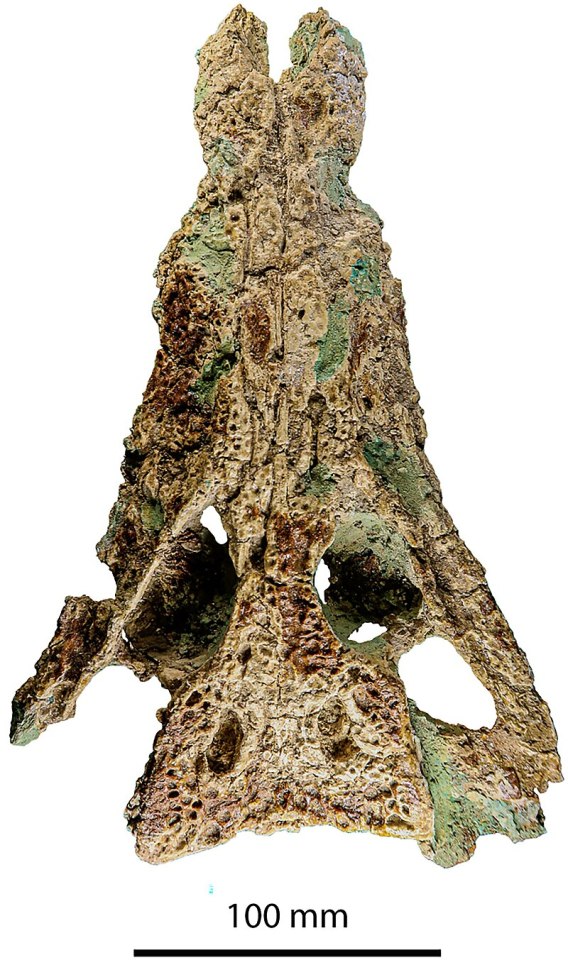

In many respects Kalthifrons looks very typical for a crocodilian, with a triangular head, rounded snout and eyes that face upwards. There are some interesting factors to mention, at least imo, and one thing thats sorta unknown. Starting with the unknown, what we aren't sure about is how deep the skull is. Sure the skull of Kalthifrons looks very intact in top view, but when looking at it from the side its about as flat as a sheet of paper. So we can't exactly tell how deep the skull would be. Maybe it was not much different from a modern croc...or maybe it was comparable to Baru the cleaver-headed crocodile. We simply don't know. The other two interesting things about its anatomy are more subtle. For one, the tip of the snout is comparably narrow. Now generally, if you look at mekosuchines the premaxilla and external nares tend to be wider than long, even in Australosuchus, but in Kalthifrons they are longer than wide. And then there's the frontal. The name Kalthifrons derives from the Latin word for forehead and the Dieri word for spear. The reason why is that the frontal bone, which covers the forehead, has an exceptionally long spear-like process at the front. Sure such a process is also found in other crocs, but in Kalthifrons it makes up 64% of this bones entire length.
A hypothetical reconstruction showing the size of Kalthifrons, which may have been around 3.4 meters.

With a length of possibly up to 3.4 meters and a triangular skull, Kalthifrons was probably a fairly generalist hunter. Fossils of Kalthifrons are known from a single place, the Golden Fleece Locality along the shores of Lake Palankarinna in the Lake Eyre basin, South Australia. Now this locality primarily yields two things. Croc fossils and turtles. Based on this and certain minerals in the sands of this locality, it has been suggested that the Golden Fleece Locality once housed a waterhole that dried up, leading to the deaths of its inhabitants.
The death of Kalthifrons as illustrated by Joschua Knüppe.
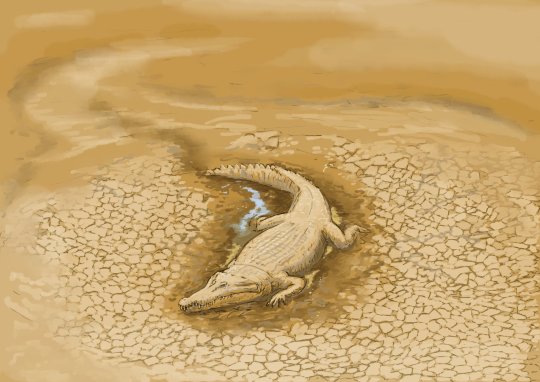
Which leads us to a bit of discussion regarding the general state of mekosuchines during the time of Kalthifrons. Now if you have read my previous posts on mekosuchines, you'll notice one thing. Most species native to continental Australia were around during the Oligocene to Miocene. Australosuchus, Baru, Ultrastenos, "Baru" huberi, Trilophosuchus and the continental Mekosuchus species. After the Miocene, continental species become rarer. Really you got Paludirex, Kalthifrons and Quinkana. And even they wouldn't stick around for much longer, with the last mekosuchines of Australia going extinct at the end of the Pleistocene.
So obviously mekosuchines experienced a drastic fall in diversity towards the end of the Miocene, clinging on for a few more million years before disappearing forever. But there's another thing that happened around this time. Modern crocodiles showed up. Contrary to popular belief, today's crocodiles of Australia are relatively recent arrivals. Freshwater crocodiles only lived there since the Pleistocene and saltwater crocodiles were likely even more recent, with both of them having evolved from different ancestors and arrived in Australia independently. But there's at least one more species of Crocodylus. The as of yet unnamed Tirari Desert Crocodile is known from remains that date to strata slightly more recent than that of Kalthifrons, displaying similar generalized anatomy. Like freshies and salties, the Tirari Crocodile arrived on its own, with phylogenetics indicating that its closest relatives were the palaeoafrican crocodiles like Crocodylus thorbjarnarsoni (a giant that grew up to 8 meters long).
Crocodylus species of Australia Top left: The freshwater crocodile (Ristevski et al. 2023) Bottom left: The saltwater crocodile (Ristevski et al. 2023) Right: Stratigraphy of the Lake Eyre Basin and successions of local crocodilians (Yates and Pledge 2017)

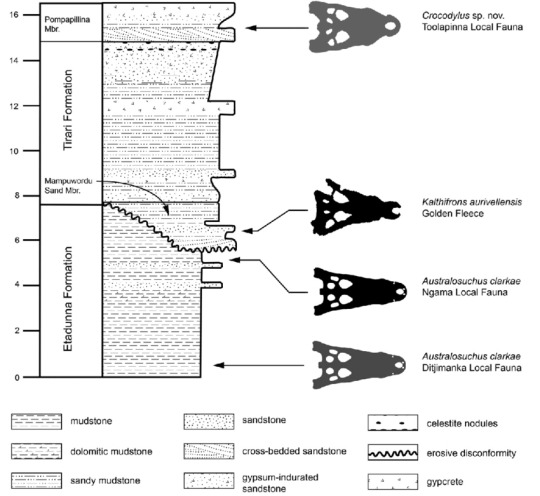
Did Crocodylus drive Kalthifrons to extinction? Well, maybe? Yates and Pledge discuss this possibility in the description of Kalthifrons, suggesting that theres some supporting pieces of information for this hypothesis. Not only does the arrival of the Tirari crocodile match up nicely with the disappearance of Kalthifrons, but they both share very similar anatomy. And conventional wisdom suggests that two crocs of the same morphotype don't really coexist in the same habitats.
But there's also points against that which aren't as openly discussed. Namely, the lack of material. Sure we have Kalthifrons in the older Mampuwordu Sand Member and the Tirari Crocodile in the younger Pompapillina Member, but remember. We only have that one Kalthifrons individual. We further know little about their habitat preferences. Sure conventional wisdom suggests crocs with similar morphology don't coexist, but that doesn't mean they don't overlap. Some species may very well be separated by the specific habitat they prefer. Slow open water, fast moving streams. Finally, is replacement necessarily the only answer? Not really. It has been deduced that Kalthifrons died in a drought and aridification is regarded as one of the main drivers of Australian megafauna extinction, as touched on in my summary of Paludirex. Maybe that's it? Kalthifrons was driven to extinction when environmental conditions grew too harsh, with Crocodylus entering the newly opened niche. This may parallel what happened in Miocene Africa, when rainforests disappeared osteolaemine crocodiles likely gave way to Crocodylus, which was better suited to the dryer climate.
Whatever the case, Kalthifrons is one of the most recent mainland mekosuchines and thus may be critical for us to determine what happened during this part of Australia's history. So sure it might not be flashy, but it's still an important little guy.
#mekosuchinae#kalthifrons#palaeoblr#prehistory#paleontology#pliocene#australia#croc#crocodilia#extinct#extinction#long post
92 notes
·
View notes
Text
What Are the Best AI Undress Tools and How Do They Work?
Artificial Intelligence (AI) tools have grown remarkably in recent years, offering advanced functionalities across many domains—from image enhancement to virtual try-on technologies. However, one category that has drawn both curiosity and controversy is the rise of “AI undress tools.” These tools utilize machine learning and image processing to simulate the removal of clothing from images, typically in a digital or visual context. While the ethical implications are serious and warrant attention, it is important to understand how these tools work, what technologies they use, and which are considered the most accurate or sophisticated.
Understanding AI Undress Tools: What Are They?
AI undress tools are applications or platforms that use neural networks to process human images and generate simulations of undressed versions of the original. These tools rely on deep learning models trained on vast datasets of human anatomy and clothing patterns. Their core functionality often includes:
Image segmentation to distinguish body parts from clothing.
Generative models such as GANs (Generative Adversarial Networks) to create realistic body textures.
Style transfer techniques to remove clothing textures and reconstruct the underlying image.
These technologies are similar to those used in medical imaging, virtual try-on systems, and photo editing software but are repurposed for simulation of clothing removal.
Applications and Ethical Concerns
Although some developers claim to offer these tools for educational, medical, or entertainment purposes, AI undress tools come with significant ethical concerns, including potential misuse, privacy violations, and consent issues. It is crucial that users understand the boundaries of ethical use and the legal frameworks in their jurisdiction before engaging with these tools.
Some legitimate use cases include:
Medical education and anatomy visualization.
Virtual fashion modeling for e-commerce platforms.
AI-generated body reconstructions for art or design concepts.
That said, many of these tools have been banned or restricted on mainstream platforms due to the risks of misuse, especially in non-consensual content generation.
Top Undress AI Tools in 2025
Despite the controversies, several AI tools have emerged in this niche. Below are some of the top undress ai tools that are often discussed in tech forums, research discussions, and visual processing communities.
1. DeepNude Alternatives
Originally infamous and taken down, DeepNude led to the creation of multiple alternatives. While the original was banned, variations of it have surfaced, often under different names and through underground networks. These tools usually feature:
Fast rendering.
GAN-based models.
Simple UI for image uploads.
Many of these tools have been removed from public domains, but they remain a benchmark for comparison.
2. Nudify AI (Conceptual Use for Medical Simulation)
Nudify AI was designed for educational simulations and medical anatomy visualization. This tool provides:
Layered views of human anatomy.
Simulation of clothing removal for educational purposes.
Strict guidelines for ethical use.
Although it doesn’t cater to casual or entertainment use, it stands out for accuracy and professionalism.
3. Undress AI (Virtual Try-On Simulator)
Some fashion-related AI companies offer “undress” modes not in the literal sense, but as part of virtual try-on tools. These simulate how garments would fit or look if removed or changed.
Enables users to preview outfit changes.
Compatible with AR devices.
Employed by online clothing retailers.
Such tools are more commercially acceptable and useful in retail and design industries.
4. AI Portrait Editor Tools
Tools like Artbreeder, Fotor, and similar AI portrait editors allow for manipulation of human features, including aging, expression, and, in some cases, body adjustments. While not explicitly “undressing,” they offer body morphing features that simulate different appearances, including implied nudity for artistic purposes.
5. Custom GAN Tools (Open Source)
Advanced users and developers can build their own AI undress tools using open-source GAN models such as:
StyleGAN by NVIDIA.
Pix2Pix or CycleGAN.
RunwayML (for low-code implementation).
These tools require technical knowledge but offer more control over ethical implementation and data management.
Best AI Undress Tool Based on Accuracy
When evaluating the best AI undress tools for accuracy, user control, and design functionality, custom GAN-based setups take the lead. They offer:
The most realistic rendering.
Data privacy (if run locally).
Modifiability based on user intention.
However, they also demand programming skills and GPU resources.
Best AI Undress Tools with Commercial or Educational Intent
If you're seeking tools for legitimate use cases such as fashion modeling or anatomy education, Undress AI for virtual try-on or Nudify AI for simulation are considered the best undress ai tools. They provide:
Legal and ethical frameworks.
High-resolution output.
Advanced AI features integrated into user-friendly platforms.
Final Thoughts
AI undress tools walk a fine line between technological innovation and ethical boundaries. While some tools serve educational, medical, or fashion-related purposes, others veer into gray or problematic areas. Anyone exploring these tools must prioritize privacy, legality, and consent at all times.
Whether you're a developer, educator, designer, or simply curious about the potential of AI in visual transformation, understanding how these systems work and what the best undress AI tools are will help you make informed, responsible decisions.
0 notes
Text
What Are the Best AI Undress Tools and How Do They Work?
Artificial Intelligence (AI) tools have grown remarkably in recent years, offering advanced functionalities across many domains—from image enhancement to virtual try-on technologies. However, one category that has drawn both curiosity and controversy is the rise of “AI undress tools.” These tools utilize machine learning and image processing to simulate the removal of clothing from images, typically in a digital or visual context. While the ethical implications are serious and warrant attention, it is important to understand how these tools work, what technologies they use, and which are considered the most accurate or sophisticated.
Understanding AI Undress Tools: What Are They?
AI undress tools are applications or platforms that use neural networks to process human images and generate simulations of undressed versions of the original. These tools rely on deep learning models trained on vast datasets of human anatomy and clothing patterns. Their core functionality often includes:
Image segmentation to distinguish body parts from clothing.
Generative models such as GANs (Generative Adversarial Networks) to create realistic body textures.
Style transfer techniques to remove clothing textures and reconstruct the underlying image.
These technologies are similar to those used in medical imaging, virtual try-on systems, and photo editing software but are repurposed for simulation of clothing removal.
Applications and Ethical Concerns
Although some developers claim to offer these tools for educational, medical, or entertainment purposes, AI undress tools come with significant ethical concerns, including potential misuse, privacy violations, and consent issues. It is crucial that users understand the boundaries of ethical use and the legal frameworks in their jurisdiction before engaging with these tools.
Some legitimate use cases include:
Medical education and anatomy visualization.
Virtual fashion modeling for e-commerce platforms.
AI-generated body reconstructions for art or design concepts.
That said, many of these tools have been banned or restricted on mainstream platforms due to the risks of misuse, especially in non-consensual content generation.
Top Undress AI Tools in 2025
Despite the controversies, several AI tools have emerged in this niche. Below are some of the top undress ai tools that are often discussed in tech forums, research discussions, and visual processing communities.
1. DeepNude Alternatives
Originally infamous and taken down, DeepNude led to the creation of multiple alternatives. While the original was banned, variations of it have surfaced, often under different names and through underground networks. These tools usually feature:
Fast rendering.
GAN-based models.
Simple UI for image uploads.
Many of these tools have been removed from public domains, but they remain a benchmark for comparison.
2. Nudify AI (Conceptual Use for Medical Simulation)
Nudify AI was designed for educational simulations and medical anatomy visualization. This tool provides:
Layered views of human anatomy.
Simulation of clothing removal for educational purposes.
Strict guidelines for ethical use.
Although it doesn’t cater to casual or entertainment use, it stands out for accuracy and professionalism.
3. Undress AI (Virtual Try-On Simulator)
Some fashion-related AI companies offer “undress” modes not in the literal sense, but as part of virtual try-on tools. These simulate how garments would fit or look if removed or changed.
Enables users to preview outfit changes.
Compatible with AR devices.
Employed by online clothing retailers.
Such tools are more commercially acceptable and useful in retail and design industries.
4. AI Portrait Editor Tools
Tools like Artbreeder, Fotor, and similar AI portrait editors allow for manipulation of human features, including aging, expression, and, in some cases, body adjustments. While not explicitly “undressing,” they offer body morphing features that simulate different appearances, including implied nudity for artistic purposes.
5. Custom GAN Tools (Open Source)
Advanced users and developers can build their own AI undress tools using open-source GAN models such as:
StyleGAN by NVIDIA.
Pix2Pix or CycleGAN.
RunwayML (for low-code implementation).
These tools require technical knowledge but offer more control over ethical implementation and data management.
Best AI Undress Tool Based on Accuracy
When evaluating the best AI undress tools for accuracy, user control, and design functionality, custom GAN-based setups take the lead. They offer:
The most realistic rendering.
Data privacy (if run locally).
Modifiability based on user intention.
However, they also demand programming skills and GPU resources.
Best AI Undress Tools with Commercial or Educational Intent
If you're seeking tools for legitimate use cases such as fashion modeling or anatomy education, Undress AI for virtual try-on or Nudify AI for simulation are considered the best undress ai tools. They provide:
Legal and ethical frameworks.
High-resolution output.
Advanced AI features integrated into user-friendly platforms.
Final Thoughts
AI undress tools walk a fine line between technological innovation and ethical boundaries. While some tools serve educational, medical, or fashion-related purposes, others veer into gray or problematic areas. Anyone exploring these tools must prioritize privacy, legality, and consent at all times.
Whether you're a developer, educator, designer, or simply curious about the potential of AI in visual transformation, understanding how these systems work and what the best undress AI tools are will help you make informed, responsible decisions.
0 notes
Text
What Are the Best AI Undress Tools and How Do They Work?
Artificial Intelligence (AI) tools have grown remarkably in recent years, offering advanced functionalities across many domains—from image enhancement to virtual try-on technologies. However, one category that has drawn both curiosity and controversy is the rise of “AI undress tools.” These tools utilize machine learning and image processing to simulate the removal of clothing from images, typically in a digital or visual context. While the ethical implications are serious and warrant attention, it is important to understand how these tools work, what technologies they use, and which are considered the most accurate or sophisticated.
Understanding AI Undress Tools: What Are They?
AI undress tools are applications or platforms that use neural networks to process human images and generate simulations of undressed versions of the original. These tools rely on deep learning models trained on vast datasets of human anatomy and clothing patterns. Their core functionality often includes:
Image segmentation to distinguish body parts from clothing.
Generative models such as GANs (Generative Adversarial Networks) to create realistic body textures.
Style transfer techniques to remove clothing textures and reconstruct the underlying image.
These technologies are similar to those used in medical imaging, virtual try-on systems, and photo editing software but are repurposed for simulation of clothing removal.
Applications and Ethical Concerns
Although some developers claim to offer these tools for educational, medical, or entertainment purposes, AI undress tools come with significant ethical concerns, including potential misuse, privacy violations, and consent issues. It is crucial that users understand the boundaries of ethical use and the legal frameworks in their jurisdiction before engaging with these tools.
Some legitimate use cases include:
Medical education and anatomy visualization.
Virtual fashion modeling for e-commerce platforms.
AI-generated body reconstructions for art or design concepts.
That said, many of these tools have been banned or restricted on mainstream platforms due to the risks of misuse, especially in non-consensual content generation.
Top Undress AI Tools in 2025
Despite the controversies, several AI tools have emerged in this niche. Below are some of the top undress ai tools that are often discussed in tech forums, research discussions, and visual processing communities.
1. DeepNude Alternatives
Originally infamous and taken down, DeepNude led to the creation of multiple alternatives. While the original was banned, variations of it have surfaced, often under different names and through underground networks. These tools usually feature:
Fast rendering.
GAN-based models.
Simple UI for image uploads.
Many of these tools have been removed from public domains, but they remain a benchmark for comparison.
2. Nudify AI (Conceptual Use for Medical Simulation)
Nudify AI was designed for educational simulations and medical anatomy visualization. This tool provides:
Layered views of human anatomy.
Simulation of clothing removal for educational purposes.
Strict guidelines for ethical use.
Although it doesn’t cater to casual or entertainment use, it stands out for accuracy and professionalism.
3. Undress AI (Virtual Try-On Simulator)
Some fashion-related AI companies offer “undress” modes not in the literal sense, but as part of virtual try-on tools. These simulate how garments would fit or look if removed or changed.
Enables users to preview outfit changes.
Compatible with AR devices.
Employed by online clothing retailers.
Such tools are more commercially acceptable and useful in retail and design industries.
4. AI Portrait Editor Tools
Tools like Artbreeder, Fotor, and similar AI portrait editors allow for manipulation of human features, including aging, expression, and, in some cases, body adjustments. While not explicitly “undressing,” they offer body morphing features that simulate different appearances, including implied nudity for artistic purposes.
5. Custom GAN Tools (Open Source)
Advanced users and developers can build their own AI undress tools using open-source GAN models such as:
StyleGAN by NVIDIA.
Pix2Pix or CycleGAN.
RunwayML (for low-code implementation).
These tools require technical knowledge but offer more control over ethical implementation and data management.
Best AI Undress Tool Based on Accuracy
When evaluating the best AI undress tools for accuracy, user control, and design functionality, custom GAN-based setups take the lead. They offer:
The most realistic rendering.
Data privacy (if run locally).
Modifiability based on user intention.
However, they also demand programming skills and GPU resources.
Best AI Undress Tools with Commercial or Educational Intent
If you're seeking tools for legitimate use cases such as fashion modeling or anatomy education, Undress AI for virtual try-on or Nudify AI for simulation are considered the best undress ai tools. They provide:
Legal and ethical frameworks.
High-resolution output.
Advanced AI features integrated into user-friendly platforms.
Final Thoughts
AI undress tools walk a fine line between technological innovation and ethical boundaries. While some tools serve educational, medical, or fashion-related purposes, others veer into gray or problematic areas. Anyone exploring these tools must prioritize privacy, legality, and consent at all times.
Whether you're a developer, educator, designer, or simply curious about the potential of AI in visual transformation, understanding how these systems work and what the best undress AI tools are will help you make informed, responsible decisions.
0 notes
Text
What Are the Best AI Undress Tools and How Do They Work?
Artificial Intelligence (AI) tools have grown remarkably in recent years, offering advanced functionalities across many domains—from image enhancement to virtual try-on technologies. However, one category that has drawn both curiosity and controversy is the rise of “AI undress tools.” These tools utilize machine learning and image processing to simulate the removal of clothing from images, typically in a digital or visual context. While the ethical implications are serious and warrant attention, it is important to understand how these tools work, what technologies they use, and which are considered the most accurate or sophisticated.
Understanding AI Undress Tools: What Are They?
AI undress tools are applications or platforms that use neural networks to process human images and generate simulations of undressed versions of the original. These tools rely on deep learning models trained on vast datasets of human anatomy and clothing patterns. Their core functionality often includes:
Image segmentation to distinguish body parts from clothing.
Generative models such as GANs (Generative Adversarial Networks) to create realistic body textures.
Style transfer techniques to remove clothing textures and reconstruct the underlying image.
These technologies are similar to those used in medical imaging, virtual try-on systems, and photo editing software but are repurposed for simulation of clothing removal.
Applications and Ethical Concerns
Although some developers claim to offer these tools for educational, medical, or entertainment purposes, AI undress tools come with significant ethical concerns, including potential misuse, privacy violations, and consent issues. It is crucial that users understand the boundaries of ethical use and the legal frameworks in their jurisdiction before engaging with these tools.
Some legitimate use cases include:
Medical education and anatomy visualization.
Virtual fashion modeling for e-commerce platforms.
AI-generated body reconstructions for art or design concepts.
That said, many of these tools have been banned or restricted on mainstream platforms due to the risks of misuse, especially in non-consensual content generation.
Top Undress AI Tools in 2025
Despite the controversies, several AI tools have emerged in this niche. Below are some of the top undress ai tools that are often discussed in tech forums, research discussions, and visual processing communities.
1. DeepNude Alternatives
Originally infamous and taken down, DeepNude led to the creation of multiple alternatives. While the original was banned, variations of it have surfaced, often under different names and through underground networks. These tools usually feature:
Fast rendering.
GAN-based models.
Simple UI for image uploads.
Many of these tools have been removed from public domains, but they remain a benchmark for comparison.
2. Nudify AI (Conceptual Use for Medical Simulation)
Nudify AI was designed for educational simulations and medical anatomy visualization. This tool provides:
Layered views of human anatomy.
Simulation of clothing removal for educational purposes.
Strict guidelines for ethical use.
Although it doesn’t cater to casual or entertainment use, it stands out for accuracy and professionalism.
3. Undress AI (Virtual Try-On Simulator)
Some fashion-related AI companies offer “undress” modes not in the literal sense, but as part of virtual try-on tools. These simulate how garments would fit or look if removed or changed.
Enables users to preview outfit changes.
Compatible with AR devices.
Employed by online clothing retailers.
Such tools are more commercially acceptable and useful in retail and design industries.
4. AI Portrait Editor Tools
Tools like Artbreeder, Fotor, and similar AI portrait editors allow for manipulation of human features, including aging, expression, and, in some cases, body adjustments. While not explicitly “undressing,” they offer body morphing features that simulate different appearances, including implied nudity for artistic purposes.
5. Custom GAN Tools (Open Source)
Advanced users and developers can build their own AI undress tools using open-source GAN models such as:
StyleGAN by NVIDIA.
Pix2Pix or CycleGAN.
RunwayML (for low-code implementation).
These tools require technical knowledge but offer more control over ethical implementation and data management.
Best AI Undress Tool Based on Accuracy
When evaluating the best AI undress tools for accuracy, user control, and design functionality, custom GAN-based setups take the lead. They offer:
The most realistic rendering.
Data privacy (if run locally).
Modifiability based on user intention.
However, they also demand programming skills and GPU resources.
Best AI Undress Tools with Commercial or Educational Intent
If you're seeking tools for legitimate use cases such as fashion modeling or anatomy education, Undress AI for virtual try-on or Nudify AI for simulation are considered the best undress ai tools. They provide:
Legal and ethical frameworks.
High-resolution output.
Advanced AI features integrated into user-friendly platforms.
Final Thoughts
AI undress tools walk a fine line between technological innovation and ethical boundaries. While some tools serve educational, medical, or fashion-related purposes, others veer into gray or problematic areas. Anyone exploring these tools must prioritize privacy, legality, and consent at all times.
Whether you're a developer, educator, designer, or simply curious about the potential of AI in visual transformation, understanding how these systems work and what the best undress AI tools are will help you make informed, responsible decisions.
0 notes
Text
What Are the Best AI Undress Tools and How Do They Work?
Artificial Intelligence (AI) tools have grown remarkably in recent years, offering advanced functionalities across many domains—from image enhancement to virtual try-on technologies. However, one category that has drawn both curiosity and controversy is the rise of “AI undress tools.” These tools utilize machine learning and image processing to simulate the removal of clothing from images, typically in a digital or visual context. While the ethical implications are serious and warrant attention, it is important to understand how these tools work, what technologies they use, and which are considered the most accurate or sophisticated.
Understanding AI Undress Tools: What Are They?
AI undress tools are applications or platforms that use neural networks to process human images and generate simulations of undressed versions of the original. These tools rely on deep learning models trained on vast datasets of human anatomy and clothing patterns. Their core functionality often includes:
Image segmentation to distinguish body parts from clothing.
Generative models such as GANs (Generative Adversarial Networks) to create realistic body textures.
Style transfer techniques to remove clothing textures and reconstruct the underlying image.
These technologies are similar to those used in medical imaging, virtual try-on systems, and photo editing software but are repurposed for simulation of clothing removal.
Applications and Ethical Concerns
Although some developers claim to offer these tools for educational, medical, or entertainment purposes, AI undress tools come with significant ethical concerns, including potential misuse, privacy violations, and consent issues. It is crucial that users understand the boundaries of ethical use and the legal frameworks in their jurisdiction before engaging with these tools.
Some legitimate use cases include:
Medical education and anatomy visualization.
Virtual fashion modeling for e-commerce platforms.
AI-generated body reconstructions for art or design concepts.
That said, many of these tools have been banned or restricted on mainstream platforms due to the risks of misuse, especially in non-consensual content generation.
Top Undress AI Tools in 2025
Despite the controversies, several AI tools have emerged in this niche. Below are some of the top undress ai tools that are often discussed in tech forums, research discussions, and visual processing communities.
1. DeepNude Alternatives
Originally infamous and taken down, DeepNude led to the creation of multiple alternatives. While the original was banned, variations of it have surfaced, often under different names and through underground networks. These tools usually feature:
Fast rendering.
GAN-based models.
Simple UI for image uploads.
Many of these tools have been removed from public domains, but they remain a benchmark for comparison.
2. Nudify AI (Conceptual Use for Medical Simulation)
Nudify AI was designed for educational simulations and medical anatomy visualization. This tool provides:
Layered views of human anatomy.
Simulation of clothing removal for educational purposes.
Strict guidelines for ethical use.
Although it doesn’t cater to casual or entertainment use, it stands out for accuracy and professionalism.
3. Undress AI (Virtual Try-On Simulator)
Some fashion-related AI companies offer “undress” modes not in the literal sense, but as part of virtual try-on tools. These simulate how garments would fit or look if removed or changed.
Enables users to preview outfit changes.
Compatible with AR devices.
Employed by online clothing retailers.
Such tools are more commercially acceptable and useful in retail and design industries.
4. AI Portrait Editor Tools
Tools like Artbreeder, Fotor, and similar AI portrait editors allow for manipulation of human features, including aging, expression, and, in some cases, body adjustments. While not explicitly “undressing,” they offer body morphing features that simulate different appearances, including implied nudity for artistic purposes.
5. Custom GAN Tools (Open Source)
Advanced users and developers can build their own AI undress tools using open-source GAN models such as:
StyleGAN by NVIDIA.
Pix2Pix or CycleGAN.
RunwayML (for low-code implementation).
These tools require technical knowledge but offer more control over ethical implementation and data management.
Best AI Undress Tool Based on Accuracy
When evaluating the best AI undress tools for accuracy, user control, and design functionality, custom GAN-based setups take the lead. They offer:
The most realistic rendering.
Data privacy (if run locally).
Modifiability based on user intention.
However, they also demand programming skills and GPU resources.
Best AI Undress Tools with Commercial or Educational Intent
If you're seeking tools for legitimate use cases such as fashion modeling or anatomy education, Undress AI for virtual try-on or Nudify AI for simulation are considered the best undress ai tools. They provide:
Legal and ethical frameworks.
High-resolution output.
Advanced AI features integrated into user-friendly platforms.
Final Thoughts
AI undress tools walk a fine line between technological innovation and ethical boundaries. While some tools serve educational, medical, or fashion-related purposes, others veer into gray or problematic areas. Anyone exploring these tools must prioritize privacy, legality, and consent at all times.
Whether you're a developer, educator, designer, or simply curious about the potential of AI in visual transformation, understanding how these systems work and what the best undress AI tools are will help you make informed, responsible decisions.
0 notes
Text
Understanding the Types of Nose Surgery for Cosmetic and Medical Needs
The face as a whole and the facial features directly impact an individual’s self-confidence in the contemporary society we live in. One of the most intricate elements of the face is the nose, which tends to be the center of concern when considering beauty enhancement procedures or medical correction of the face.

In India, different types of nose surgery are performed, catering to aesthetic and medical needs, whether it is for correcting the breathing function of the nose or for beautifying its shape.
The integration of modern medicine and rising levels of knowledge amongst the general public have resulted in more people looking to get cosmetic surgery for the nose for both beauty and necessity.
Procedures that were once the privilege of the elite classes can now be conducted at renowned clinics such as Cosmetic Laser Surgery Center, Pune, which has earned a reputation for its highly qualified surgeons and sophisticated medical equipment.
This article discusses the types of nose surgeries available, including different types of nose plastic surgery and assists you with the choice that best serves your aims.
Understanding the Different Types of Nose Surgery?
Surgical rhinoplasty, commonly known as a “nose job,” serves two functions aesthetic and reconstructive, nose surgery helps refine its shape, size, or symmetry which results in better facial balance and self-esteem for the patient.
On the other hand, medical issues request surgeries such as repairs to bones or cartilage, breathing problems, or damaged nose from accidents. These different types of nose surgery meet the needs of the majority which is why they are preferred by patients looking for customized solutions.
If you’ve been suffering in silence from relentless sinus issues, or are inspired by glamourized Bollywood features, knowing the different types of nose surgeries will help you pick a strategy that meets your expectations.
Exploring the Different Types of Nose Surgery
Here’s a comprehensive look at the most common types of nose surgery available today:
Type of Nose Surgery:
Rhinoplasty: Cosmetic reshaping of the nose
Ideal For : Those looking to improve nose shape
Septoplasty: Correction of deviated nasal septum
Ideal For : Patients with breathing difficulties
Functional Rhinoplasty: Combines aesthetic and medical goals
Ideal For : Individuals needing both form and function
Tip Plasty: Refining the nasal tip
Ideal For : People who want subtle cosmetic changes
Alarplasty: Adjusting the nostrils’ size and shape
Ideal For : Those with wide or flared nostrils
Non-Surgical Rhinoplasty: Uses dermal fillers to reshape nose temporarily
Ideal For : People avoiding surgery but wanting change
Choosing the Right Type of Nose Surgery
Choosing the different types of nose surgery that you want done will depend on your goals, medical background, and facial anatomy. The Cosmetic Laser Surgery Center in Pune provides the best comprehensive consultations with expert surgeon such as Dr. Chaudhari who analyze your problems and provide tailored recommendations.
During consultations, expect a detailed evaluation, including:
Goal Identification: Functional vs Aesthetic.
Nasal examination.
Guidelines on and preparation regarding the reducing smoking or aspirin intake to mitigate swelling risks.
Cultural concerns such as feature preservation are crucial for patients. India is known for its diverse beauty standards, which is why ethnic rhinoplasty is specialized to ensure features are preserved and results are culturally appropriate.
How Safe Is Nose Surgery?
As with any medical procedure, one has to consider the risks that come with different types of nose plastic surgery. These risks are significantly lower, however, when the procedure is done by experienced professionals at accredited centres. Our facility meets all criteria concerning cleanliness, safety, and post operative care to therapeutically meet the needs of each patient using the other systems as needed to ensure satisfaction.
Conclusion
Having knowledge of the different types of nose surgery allows one to make informed decisions depending on the cosmetic or medical need. For those seeking cosmetic finesse, cosmetic surgery for nose, or for relief from breathing problems, there are options like septoplasty, rhinoplasty, and turbinate reduction that provide customizable solutions.
In terms of expertise and advanced technologies for surgery, The Cosmetic Laser Surgery Center located in Pune is the epicentre patients trust most.
If you are ready to boost your self confidence or want to breathe easy contact us today for a consultation on types of nose surgeries best fulfills your needs cosmetically.
FAQs
1. What are the different types of nose plastic surgery?
Rhinoplasty, septoplasty, tip plasty, alarplasty, and non-surgical rhinoplasty.
2. How long does it take to recover from nose surgery?
About 1–2 weeks for basic recovery; full results in a few months.
3. Can nose surgery correct breathing problems?
Yes, septoplasty and functional rhinoplasty help improve breathing.
4. How do I choose the right surgeon for nose surgery?
Look for experience, certifications, and patient reviews.
0 notes